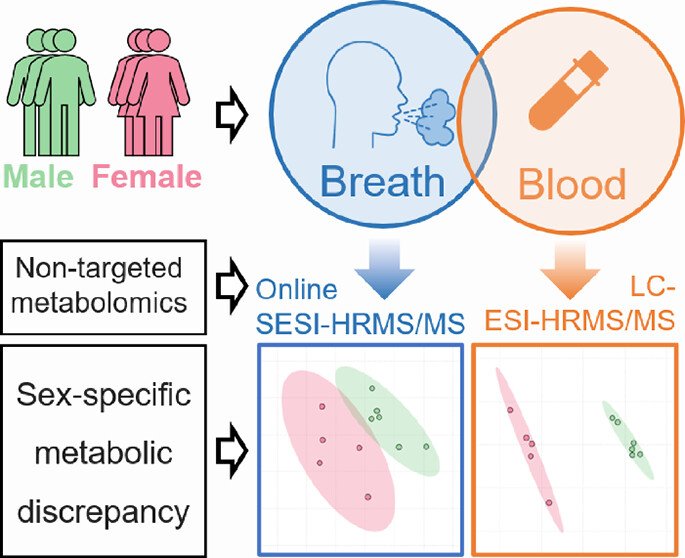Urinary marker of oxidative stress in children correlates with molecules in exhaled breath
A. Gisler, K. D. Singh, A. Marten, F. Decrue, U. Frey, P. Sinues and J. Usemann
Real-time breath analysis via secondary electrospray ionization high-resolution mass spectrometry (SESI-HRMS) shows promise as a non-invasive tool for assessing oxidative stress. In a study involving 128 children (25 tobacco smoke-exposed, 103 non-exposed), 71 breath features significantly correlated with urinary levels of the oxidative stress marker 8-iso-prostaglandin F2α (8-iso-PGF2α). Breath analysis moderately predicted urinary 8-iso-PGF2α (concordance correlation: 0.37 ± 0.05), suggesting potential clinical applicability
Breath and Blood Metabolomics: A Comparative Study Using SESI-HRMS/MS and UHPLC-ESI-HRMS/MS
Zhifeng Tang, Jianming Yang, Xin Xu, Keda Zhang, Huiling Wang, Xin Luo, Mingliang Fang, Tao Huan, Xue Li
Breath metabolomics enables noninvasive and rapid acquisition of metabolic information by detecting volatile organic compounds (VOCs) in exhaled breath. Secondary electrospray ionization high-resolution tandem mass spectrometry (SESI-HRMS/MS) offers the highest coverage for detecting breath metabolites among current real-time breath analysis techniques. Although it has been generally recognized that metabolites in breath originate from the blood, a molecular-level understanding of the characteristics of metabolites in both breath and blood remains insufficient. In this study, nontargeted analyses of breath and blood samples from 11 healthy volunteers were performed using SESI-HRMS/MS and ultrahigh performance liquid chromatography electrospray ionization high-resolution tandem mass spectrometry (UHPLC-ESI-HRMS/MS), respectively…
Pain induces a rapid characteristic metabolic signature detectable in breath
P. Sinues, M. Richard, K. Singh, D. Sezer, S. Buergler, L. Palermo, Y. Schulz, Z. Tang, X. Luo, U. Frey, P. Cattin, X. Li, J. Gaab
Accurately assessing pain in vulnerable populations—such as children, the elderly, and unconscious patients—remains a critical challenge in healthcare. A new study explores the potential of breath metabolomics as a real-time, objective tool for pain evaluation. Using the cold pressor test (CPT) to induce pain, researchers analyzed exhaled breath with high-resolution mass spectrometry, identifying over 400 metabolic changes within 15 minutes. Key pathways linked to pain signaling, including amino acid metabolism and neurotransmitter activity, showed significant shifts. A neural network classifier effectively distinguished pre- and post-CPT states (AUC=0.856), highlighting the promise of this approach. These findings align with chronic pain research, suggesting a deeper metabolic connection to pain perception. This breakthrough paves the way for observer-independent pain monitoring, with future research needed to tailor insights for personalized pain management strategies.
Rapid detection of Tulipalin A with SESI-Orbitrap MS: an exploration across spring flowers
Kim Arnold, Alejandro Gómez-Mejia, Miguel de Figueiredo, An N. T. Phan, Roy Eerlings, Hendrik G. Mengers & Lars M. Blank
Here, we demonstrated the secondary electrospray ionization coupled Orbitrap mass spectrometry (SESI-Orbitrap MS) methodology for quantifying tulipalin A release from plants upon injury.





